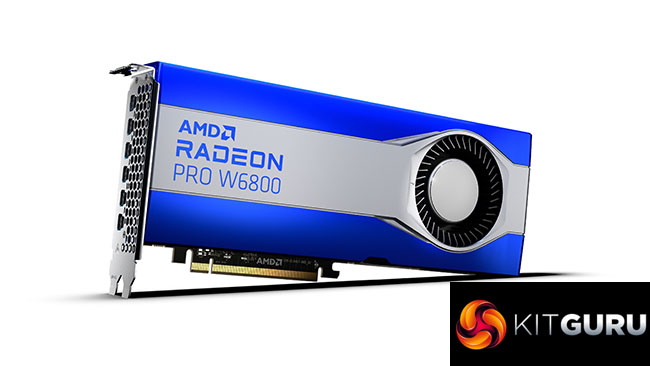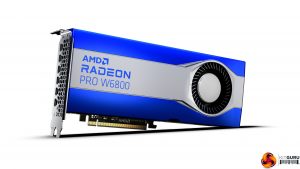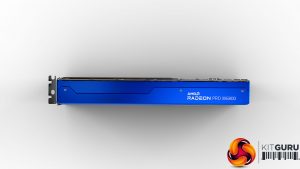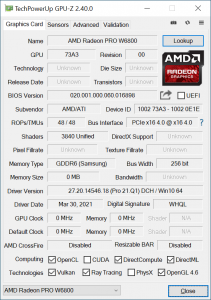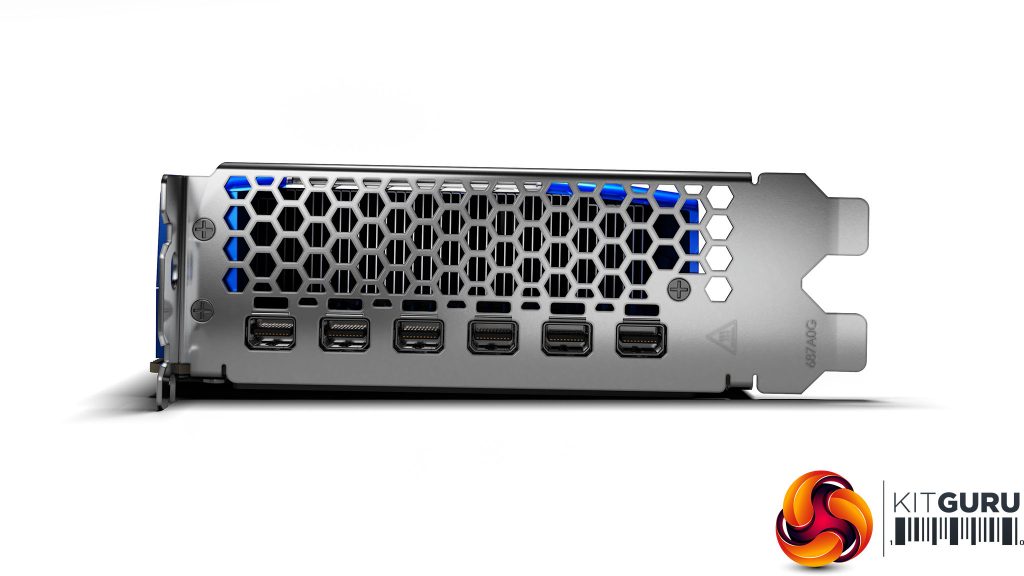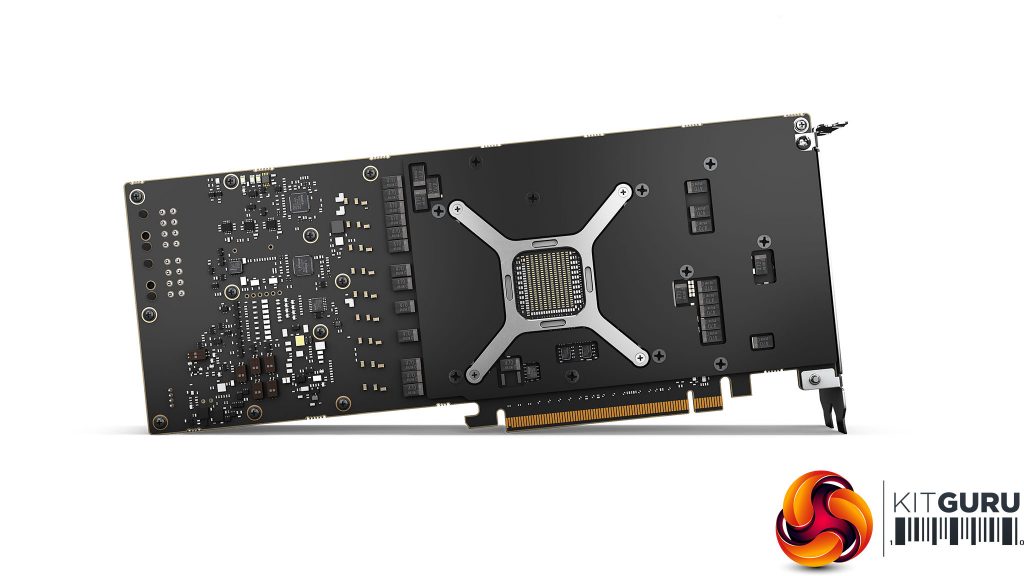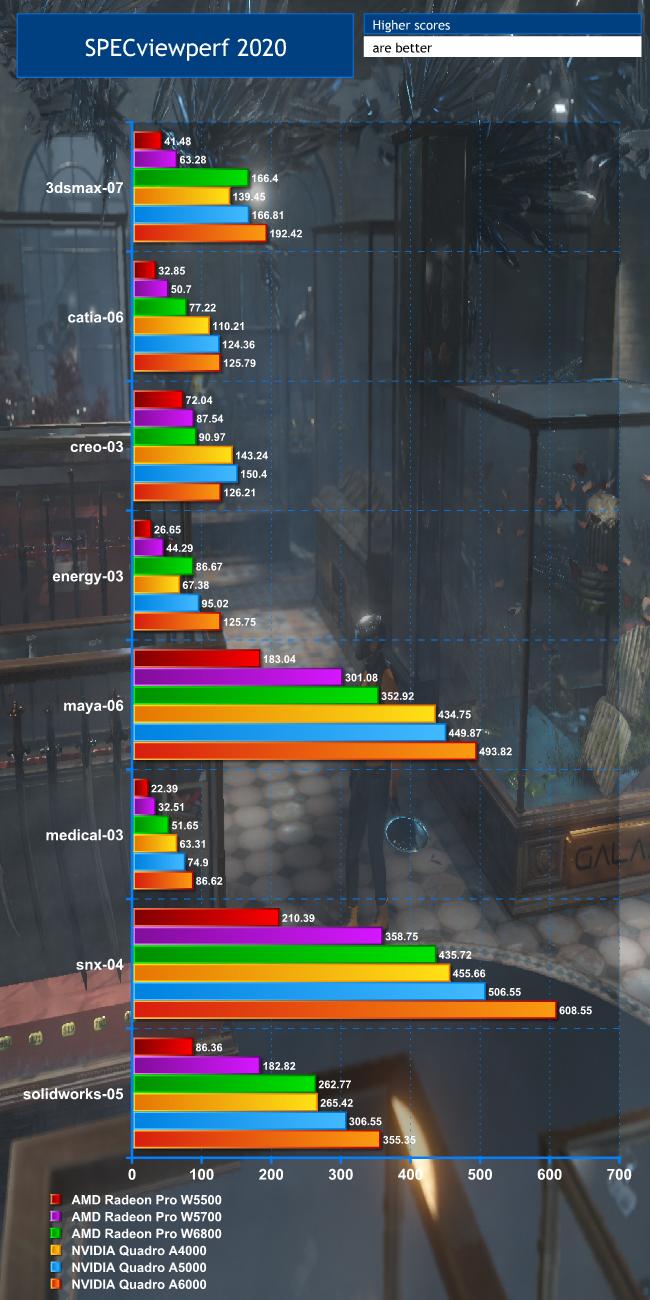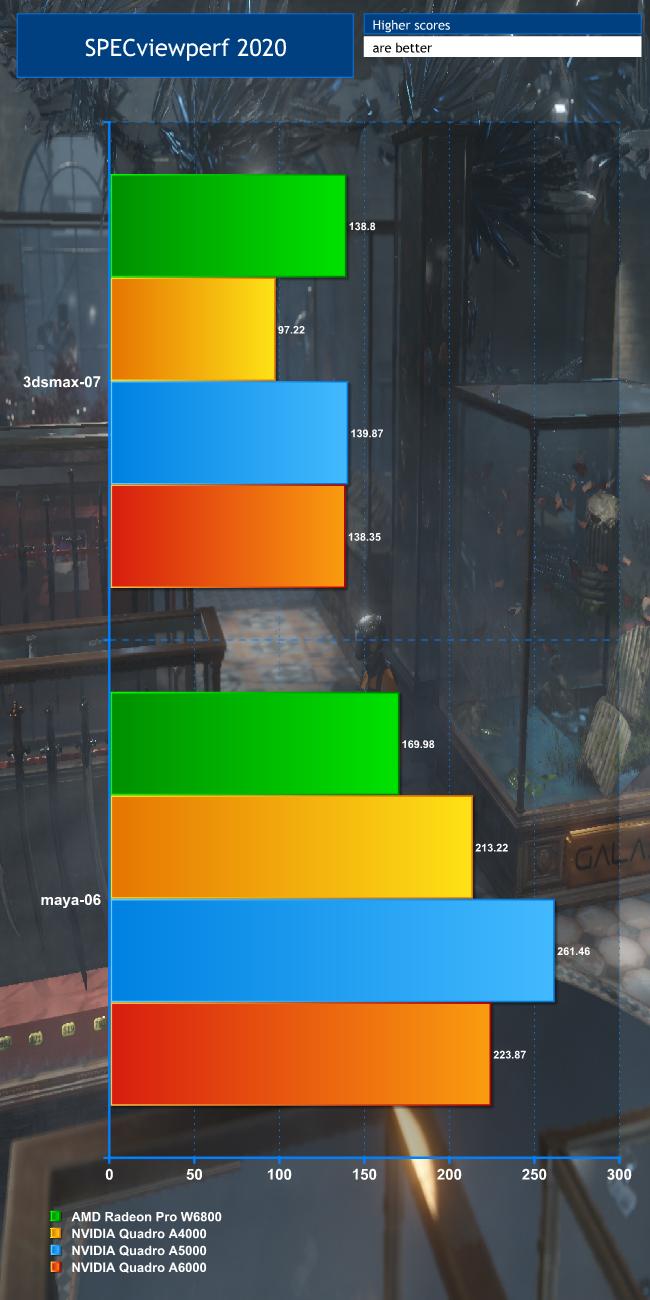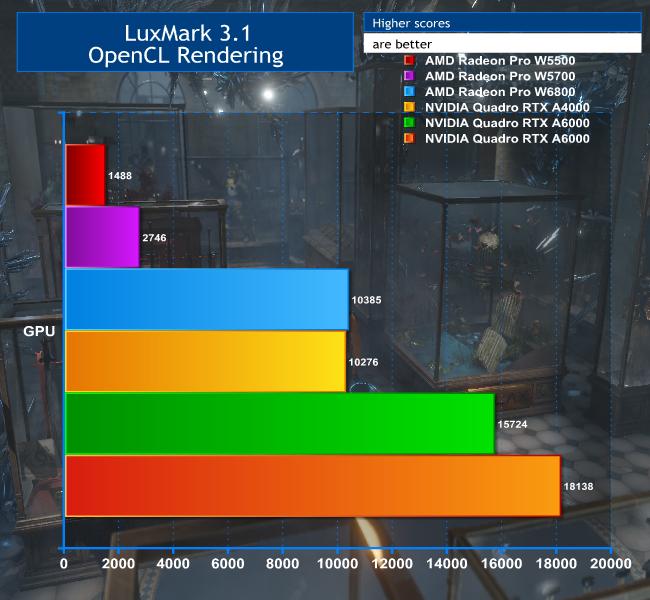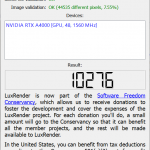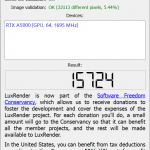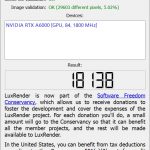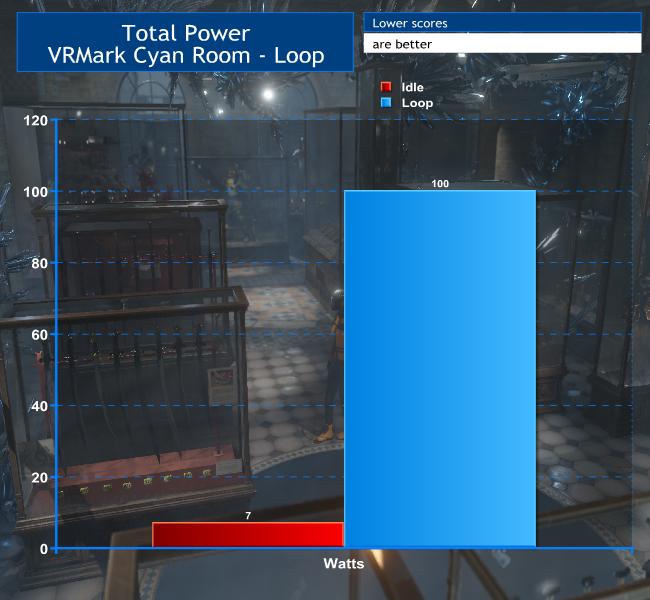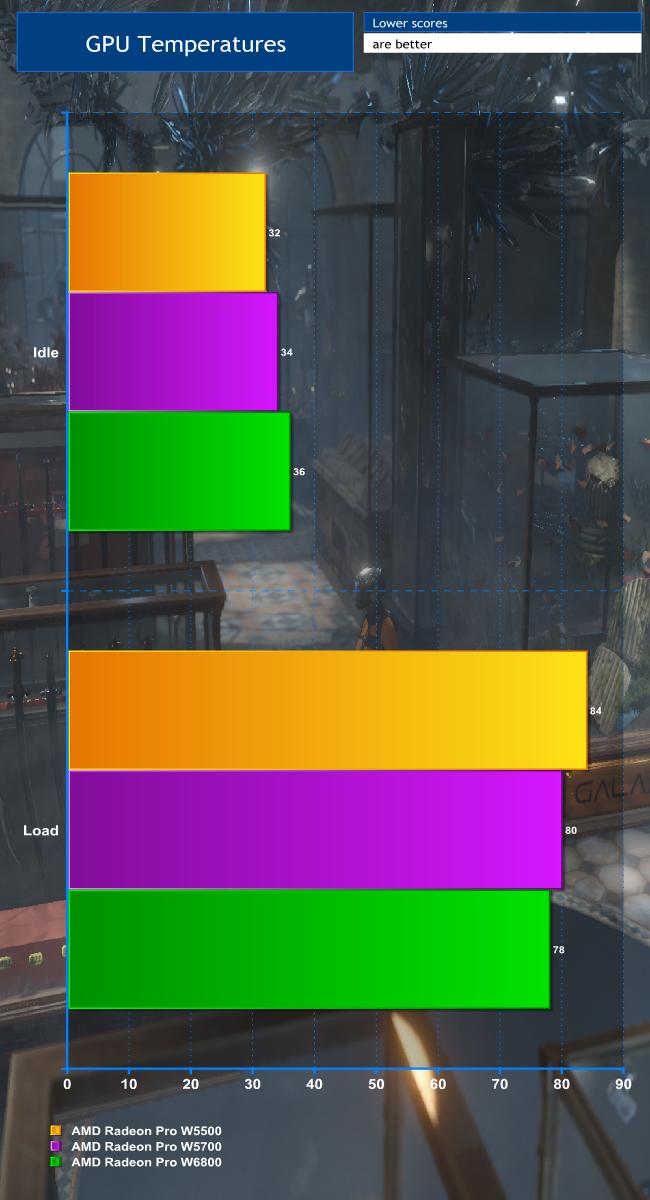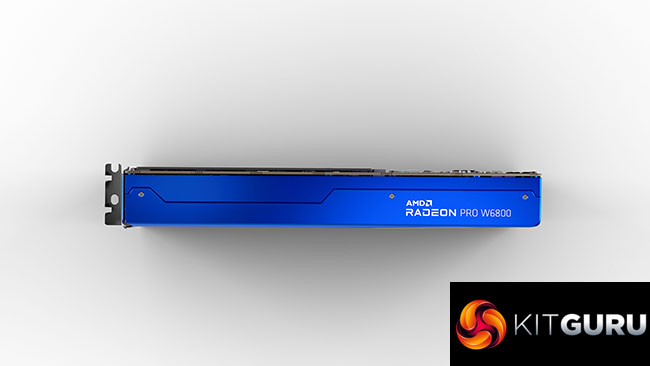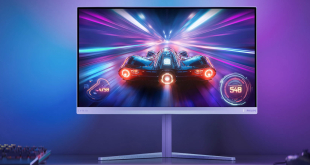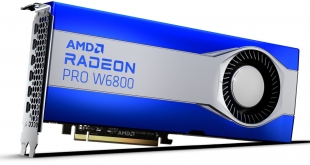
AMD's CPUs have taken over the workstation market, made huge inroads for servers and cloud providers, and its Instinct GPUs are now being used in the fastest supercomputers in the world, like the Oak Ridge Frontier and Nuclear Security Administration's El Capitan. But it still plays a very quiet second fiddle to NVIDIA in the mainstream workstation graphics market. AMD is still chipping away, though, and each generation gets that little bit closer to a serious challenge. With the latest Radeon Pro W6000 series, AMD is bringing its 7nm RDNA2 architecture to the professional arena, and we got our hands on the top W6800 model.
The W6800 follows on the heels of the AMD Radeon Pro W5700 and W5500, but is a significant upgrade over either. The manufacturing process is still 7nm, but this card now uses Navi 21 from AMD's RDNA 2.0 architecture, also known as “Big Navi”. This is the same generation as the AMD Radeon RX 6000 series gaming cards, in particular the Radeon RX 6800, 6800 XT and 6900 XT. As the W6800's name suggests, it is most closely related to the RX 6800, sporting 60 compute units and 3,840 stream processors.
So the W6800 has 67 per cent more Stream Processors than the W5700, but the big news is just how much memory it has on board – a whopping 32GB. This is GDDR6, delivered on a 256-bit bus with 512GB/sec bandwidth. Putting this in perspective, this is four times as much as the W5700, twice as much as any previous professional AMD card apart from the Apple Mac Pro-only Radeon Pro Vega II, and more than any NVIDIA Quadro except the RTX 8000, A6000 or GV100.
In other words, the AMD Radeon Pro W6800 is designed to handle huge viewsets that were previously just the domain of the highest-end NVIDIA Quadro cards costing around £5,000 (in the case of the RTX 8000) or £4,500 (in the case of the RTX A6000). You won't get much change out of £9,000 for a GV100.
The W6800 wasn't listed for sale on any UK website at the time of writing, but in the US it is available for $2,499 (£1,797) which is in the same ballpark as the NVIDIA Quadro RTX A5000. It has a third more memory than the latter, but how does it compete on performance? We managed to get our hands on all the latest Ampere-generation NVIDIA Quadro RTX cards to compare. Read on to see how it shapes up.
| GPU | AMD Radeon Pro W5700 |
AMD Radeon Pro W5500 |
AMD Radeon Pro W6800 |
| Compute Units |
36 | 22 | 60 |
| Stream Processors |
2,304 | 1,408 | 3,840 |
| GPU Architecture / Variant | Navi 10 XL | Navi 14 PRO XL | Navi 21 |
| Base Clock | 1,183 MHz | 1,354 MHz | 2,075 MHz |
| GPU Boost Clock | 1,930 MHz | 1,855 MHz | 2,320 MHz |
| Total Video memory | 8 GB GDDR6 | 8 GB GDDR6 | 32 GB GDDR6 |
| Memory Clock (Effective) |
1,750 (14,000) MHz | 1,750 (14,000) MHz | 2,000 (16,000) MHz |
| Memory Bandwidth | 448 GB/sec | 224 GB/sec | 512 GB/sec |
| Bus Width | 256-bit | 128-bit | 256-bit |
| Manufacturing Process | 7nm | 7nm | 7nm |
| TDP | 205 W | 125 W | 250 W |
| Display Outputs | 5 x Mini-DisplayPort 1.4, USB-C | 4 x DisplayPort 1.4 | 6 x Mini-DisplayPort 1.4 |
| Display Resolution |
5 @ 1920×1080
5 @ 3840×2160
5 @ 5120×2880
1 @ 7680×4320
(all at 60Hz)
|
4 @ 1920×1080
4 @ 3840×2160
4 @ 5120×2880
1 @ 7680×4320
(all at 60Hz)
|
6 @ 1920×1080 6 @ 3840×2160 6 @ 5120×2880 2 @ 7680×4320 (all at 60Hz)
|
| Software API Support | DirectX 12, OpenGL 4.6, OpenCL 2.1, Vulkan 1.2 | DirectX 12, OpenGL 4.6, OpenCL 2.1, Vulkan 1.2 | DirectX 12 Ultimate, OpenGL 4.6, OpenCL 2.1, Vulkan 1.2 |
AMD Radeon Pro W5500 Retail Price: $2,499 (£1,797)
The Radeon Pro W6800 maintains the familiar blue appearance of recent Radeon Pros, with the silver strip down the middle showing the model and branding. This is a hefty dual-slot card, with a reassuringly solid build and decently sized fan, although just a single one.
The W6800 benefits from PCI Express 4.0, although Ampere-generation NVIDIA Quadro RTX cards also support this. Although the W6800 has the same number of Stream Processors (3,840) as the Radeon RX 6800, they are clocked at a higher frequency – 2,075MHz base with a 2,320MHz boost, compared to 1,700MHz with a 2,105MHz boost for the RX 6800. This enables the W6800 to deliver 17.83TFLOPS of single precision compute, compared to 16.17TFLOPS for the RX 6800.
The memory performance is identical, however, albeit the amount supplied twice as much. The bus is 256-bit and the GDDR6 runs at 2,000MHz octo-pumped to 16,000MHz, delivering 512GB/sec. This is more than NVIDIA's latest Quadro RTX A4000 (448GB/sec), but the A5000 and A6000 have more bandwidth (768GB/sec). The AMD Radeon Pro W5700 also delivers 448GB/sec memory bandwidth, so the W6800 beats that, as well as sporting 67 per cent more Stream Processors operating at a faster clock. It should be a much faster card than the W5700.
The AMD Radeon Pro W6800 is so new that TechPowerUp GPU-Z doesn't recognise it properly. However, it correctly detects the 3,840 Stream Processors, PCI Express 4.0 bus and 256-bit memory bus.
With such a huge amount of memory on board, you would expect the W6800 to support very large monitor resolutions. Like the W5700, Mini-DisplayPort connections are employed to enable six of them in a row. Each of these can support displays up to 5K at 60Hz, so you could create a six-monitor wall 15K across and two screens high. Two 8K (7,680 x 4,320) screens can be supported at once, too. All the Mini-DisplayPort connections are 1.4 level.
All the usual acceleration APIs are supported, including OpenCL 2.1, OpenGL 4.6, Vulkan 1.2 and DirectX 12 Ultimate. The latter adds DirectX Raytracing 1.1, which the W6800 accelerates in hardware, alongside Variable Rate Shading, Mesh Shaders and Sampler Feedback.
The W6800 requires both eight-pin and six-pin power connections, with a peak draw of 250W. That is less than the NVIDIA Quadro RTX 5000, which peaks at 265W, but the A5000 has dropped this to 230W. Still, this is not a power-hungry card considering its capabilities. It is clearly a major upgrade over the AMD Radeon Pro W5700, and any other mainstream professional card AMD has produced so far.
We tested the AMD Radeon Pro W6800 in an Armari Magnetar M64TP-AW1200G3 workstation. This is a hugely powerful workstation based around a 32-core AMD Threadripper PRO 3975WX processor, backed with 128GB of 3,200MHz ECC Registered DDR4 SDRAM.
For comparison, we pitted the AMD Radeon Pro W6800 against the AMD Radeon Pro W5500, W5700 and NVIDIA's Quadro RTX A4000, A5000 and A6000, although the two other AMD cards were tested previously in a different system with a similar specification.
Software:
SPECviewperf 2020
Blender 2.93.2
LuxMark 3.1
Armari Magnetar M64TP-AW1200G3 Specifications:
- AMD Ryzen Threadripper PRO 3975WX @ 3.5GHz
- CoolerMaster MasterLiquid ML360 360mm Water Cooling
- 128GB ECC Registered DDR4 SDRAM @ 3,200MHz
- ASUS Pro WS WRX80E-SAGE SE WiFi Motherboard
- 2 x 2TB Samsung 980 Pro M.2 NVMe PCI Express 4.0 SSDs
- 1,200W ASUS ROG Thor 80+ Platinum Efficiency PSU
- Armari Magnetar M60G3 P01 Pro Chassis
- Windows 10 Professional 64-bit
- 3 Years Warranty (1st Year Collect and Return, 2nd and 3rd Years RTB Parts and Labour)
SPECviewperf 2020
The SPECviewperf® 2020 benchmark, released on October 14, 2020, is the worldwide standard for measuring graphics performance based on professional applications. The benchmark measures the 3D graphics performance of systems running under the OpenGL and Direct X application programming interfaces. The benchmark’s workloads, called viewsets, represent graphics content and behaviour from actual applications, without the need to install the applications themselves.
Major updates in SPECviewperf 2020 include:
- New viewsets taken from traces of the latest versions of 3ds Max, Catia, Maya, and Solidworks applications.
- Updated models in the viewsets based on 3ds Max, Catia, Creo, Solidworks, and real-world medical applications.
- Support within all viewsets for both 2K and 4K resolution displays.
- User interface improvements, including better interrogation and assessment of underlying hardware, clickable thumbnails of screen grabs, and a new results manager.
- Support for running the benchmark using command-line options.
Although professional graphics cards are increasingly being employed for tasks other than real-time 3D viewport acceleration, this is still their “meat and potatoes”, so the SPECviewperf 2020 test is the fundamental assessment to run.
The W6800 is significantly faster than the W5500 and W5700 in every test.
However, while it is 19 per cent faster than the NVIDIA Quadro RTX A4000 in the 3dsmax-07 viewset, the A5000 matches it and the A6000 is 16 per cent faster still.
The catia-06 viewset gives the NVIDIA cards a clear lead, with the A4000 beating the W6800 by 43 per cent, the A5000 by 61 per cent, and the A6000 by 63 per cent.
The deficit continues with the creo-03 viewset, where the Quadro RTX A4000 is 57 per cent faster and the A5000 is 65 per cent faster. However, the A6000 was strangely only 39 per cent faster.
The energy-03 viewset was a bit more positive for AMD, with the W6800 beating the A4000 by 29 per cent. The energy-02 viewset is based OpendTect seismic visualisation, so is aimed at applications like oil and gas prospecting. The A5000 only beat the W6800 by 10 per cent, and the A6000 by 45 per cent.
The maya-06 viewset was back to NVIDIA dominance, with the A4000 beating the W6800 by 23 per cent, the A5000 by 27 per cent, and the A6000 by 40 per cent.
With medical-03 the A4000 beats the W6800 by 23 per cent, the A5000 beats it by 45 per cent, and the A6000 beats it by 68 per cent. This viewset simulates activities such as MRI scanner outputs.
The snx-04 viewset is based on Siemens NX, which is a very popular product design and engineering application. The W6800 is a bit closer to NVIDIA here. The A4000 only wins by 5 per cent, the A5000 by 16 per cent, and the A6000 by 40 per cent.
Results were similar with solidworks-05, which is also based on CAD software used frequently for product design. The A4000 was only 1 per cent faster than the W6800, but the A5000 was 17 per cent quicker, and the A6000 was 35 per cent faster.
In other words, this is a comprehensive win for NVIDIA. Only with 3ds Max and the energy-03 viewset does the AMD Radeon Pro W6800 beat any of the latest Ampere-generation Quadro RTX cards, and even then it's the A4000 that is in a lower price band. The AMD Radeon Pro W6800 really needed to be competing strongly with the A5000, and it clearly doesn't. However, one area where AMD has argued its cards do beat NVIDIA's is multitasking. Now that AMD workstations can sport up to 64 cores (our test rig had 32), it is clearly valuable to do something like rendering in the background but still be able to perform design work simultaneously. So next we turn to a test of this capability.
SPECviewperf 2020 and Blender Render
For this test, we set off the Blender Gooseberry benchmark render on a copy of Blender 2.93.2 running on CPU. We set this to render a series of frames so it would take a long time. This is a very highly multithreaded application, which will use all the resources it can.Once the render was running, we fired off the SPECviewperf 2020 test, but only ran 3dsmax-07 and maya-06, because while you would do 3D animation design while rendering a 3D animation, you probably won't be engaged in CAD or scientific visualisation.
With 3ds Max, the W6800 is running at 83 per cent of full speed, the A4000 is at 70 per cent, and the A6000 at 72 per cent, but the A5000 is at 84 per cent. So the W6800 is doing well, but you could hardly call any of the NVIDIA cards unusable.
With Maya, the W6800 is at 48 per cent speed, the A4000 at 49 per cent, the A5000 at 52 per cent, but the A6000 has fallen to 37 per cent of its original performance.
Overall, then, while the W6800 is clearly capable at multi-tasking, so are the NVIDIA Ampere cards. And, since they are faster to begin with, the final frame rate is higher.
LuxMark 3.1
OpenCL is a platform for harnessing GPU power for activities other than real-time 3D rendering to screen, also known as GPGPU. Unlike NVIDIA’s CUDA platform, OpenCL is open source and can be ported to anything with processing power. So drivers are available for CPUs as well, both from Intel and AMD. NVIDIA's graphics cards also support OpenCL, and the latest Ampere cards can handle 3.0, whereas the AMD cards remain on version 2.1.
A popular tool for testing OpenCL performance is LuxMark. We rendered the most gruelling Hotel Lobby scene.
The AMD Radeon PRo W6800 clearly has a LOT more grunt than the AMD Radeon Pro W5500 or W5700. However, this test is very telling as an explanation for earlier results. The W6800 has a marginally more powerful OpenCL ability than the NVIDIA Quadro RTX A4000 (1 per cent), but the A5000 is 51 faster than the W6800, and the A6000 is 75 per cent faster.
In other words, while AMD has clearly moved forward a lot with the Navi 21, NVIDIA's Ampere has taken the goalposts and shifted them to another pitch.
Power Consumption
One area where the W6800 has a strong proposition, however, is power consumption. For this test, we fired up the VRMark Cyan Room benchmark in a loop, and compared the eventual peak power draw with when the card was idle and doing nothing.
Although the W6800 is rated at 250W peak, the GPU was only consuming 100W, which is rather frugal.
Temperature
We also checked the temperature of each card before we began the VRMark loops, and then once it had settled to a constant value. Here we were able to compare to previous AMD cards, although these were on a different machine at a different time and with different room temperature.
The idle GPU temperature of 36C looks high, but this was a very hot UK summer day (during the recent heat wave), so the delta with the temperature under full load is the most important to consider. Under load, the W6800's temperature has risen by 42C, whereas the W5500 rose by 52C and the W5700 by 46C. So the W6800 clearly runs cool.
The AMD Radeon Pro W6800 is unfortunately not the professional accelerator to revive AMD's fortunes in this market. It is an unquestionably quick card compared to previous generations, and the 32GB of frame buffer will be a real boon for some texture sets and workloads. The NVIDIA Quadro RTX A5000 only offers 24GB, and if you want more you will need the much more expensive A6000.
But otherwise, the W6800 lags behind all of NVIDIA's Ampere Quadro RTX generation in performance, even the cheaper A4000, except in a couple of applications (most notably 3ds Max). Unless you can really make use of that 32GB of GDDR6, the A5000 is the faster choice, and for most activities even the A4000 will outperform the W6800. The A4000 only has 16GB of frame buffer, half as much as the W6800, but for many 3D content creation activities this will be more than enough.
There are other considerations than just raw performance. The W6800 is frugal on power and runs cool. It also sports six monitor outputs, enabling really huge multi-screen arrays. It is also quite capable even when your system is doing something strenuous in the background like rendering, although NVIDIA's latest cards are similarly good.
Overall, though, we had expected more from the AMD Radeon W6800. It's competitive with the original NVIDIA Quadro RTX generation, but NVIDIA has moved on a lot with Ampere, raising the bar out of reach again.
While AMD is wiping the floor with Intel in the professional CPU space, yet again it appears to be a generation behind NVIDIA in graphics acceleration performance.
The AMD Radeon Pro W6800 is available from B&H Photo in the USA for $2,499.
Pros:
- Huge 32GB memory.
- Frugal on power consumption.
- Runs cool under load.
- Extensive multi-monitor options with six Mini-DisplayPort outputs.
- Support for two 8K 60Hz monitors.
Cons:
- Roundly beaten by NVIDIA's Ampere Quadro RTX cards in most professional applications.
- Only slightly more OpenCL power than the cheaper NVIDIA Quadro RTX A4000.
KitGuru says: The AMD Radeon Pro W6800 moves the bar up considerably over previous AMD professional cards, but NVIDIA's Ampere generation Quadro RTX range has moved the bar to a completely different stadium.
 KitGuru KitGuru.net – Tech News | Hardware News | Hardware Reviews | IOS | Mobile | Gaming | Graphics Cards
KitGuru KitGuru.net – Tech News | Hardware News | Hardware Reviews | IOS | Mobile | Gaming | Graphics Cards


